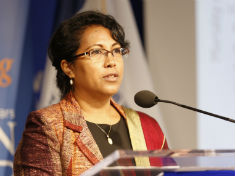-
Eliane Razafimandimby: Improving the Quality of Maternal and Child Care
October 12, 2018 By Elizabeth Wang “Even in a weak system without a quality improvement structure, it is possible to support district managers and facility providers to measure and improve quality care,” said Eliane Razafimandimby, Chief of Party of USAID’s flagship Maternal and Child Survival Program (MCSP) in Madagascar, at a recent Wilson Center event on improving the quality of reproductive, maternal, newborn, and child healthcare (RMNCH).
“Even in a weak system without a quality improvement structure, it is possible to support district managers and facility providers to measure and improve quality care,” said Eliane Razafimandimby, Chief of Party of USAID’s flagship Maternal and Child Survival Program (MCSP) in Madagascar, at a recent Wilson Center event on improving the quality of reproductive, maternal, newborn, and child healthcare (RMNCH).“Even in a weak system without a quality improvement structure, it is possible to support district managers and facility providers to measure and improve quality care,” said Eliane Razafimandimby, Chief of Party of USAID’s flagship Maternal and Child Survival Program (MCSP) in Madagascar, at a recent Wilson Center event on improving the quality of reproductive, maternal, newborn, and child healthcare (RMNCH).
Madagascar is currently in the early stages of improving the quality of its RMNCH care. After failing to meet the maternal and newborn Millennium Development Goals by 2015, the government created a roadmap to achieving the maternal and newborn MDGs by 2019 and mandated MCSP to support the Ministry of Health in strengthening its health system to reduce maternal and newborn mortality.
In order to have an impact on quality, “we needed to engage with the health system at different levels,” said Razafimandimby. A systems approach required emphasis on policy at the national level, capacity-building and data usage at the district/regional level, and targeted service-delivery support and community engagement at the facility level.
The ambitious task of assessing quality of care and implementing change involved nearly two-thirds of the country, across 16 regions and 80 districts. Quality care indicators monitored at more than 600 facilities showed promising reductions in maternal and newborn mortality.
Health facilities implemented preventative measures to improve quality. Having a newborn station in the operating room after a C-section allowed midwives to care for the baby without having to carry him or her to the neonatal unit for care, which was often located in another building. This small change facilitated more immediate newborn care as well as greatly reduced the risk of infection. Other improved outcomes were linked to significant increases in antenatal screening for preeclampsia and the adoption of postpartum family planning methods before discharge from a facility. “These improved outcomes were not only seen at the primary facility level but also at district and regional hospitals,” said Razafimandimby.
Despite success at the facility, district, and regional levels, national progress is slow. “Development of a national quality strategy and structure remains a high priority for Madagascar,” said Razafimandimby. “To be able to sustain and continue improvement work, national level leadership is really essential.”
This audio was recorded at an event at the Wilson Center on September 18, 2018.
Sources: Maternal and Child Survival Program, UN Millennium Development Goals
Friday Podcasts are also available for download on iTunes and Google Podcasts.
 A Publication of the Stimson Center.
A Publication of the Stimson Center.

 “Even in a weak system without a quality improvement structure, it is possible to support district managers and facility providers to measure and improve quality care,” said
“Even in a weak system without a quality improvement structure, it is possible to support district managers and facility providers to measure and improve quality care,” said 

